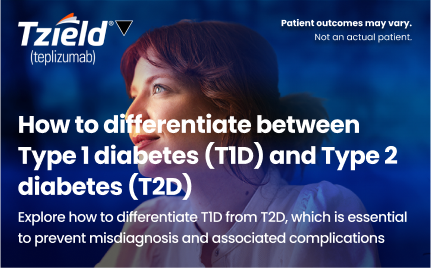It can be difficult to distinguish between the initial symptoms of autoimmune T1D and symptoms of T2D1

Key differences between T1D and T2D include:
| T1D | T2D |
|---|---|
| Around 8% of people with diabetes have T1D†2 | Around 90% of people with diabetes have T2D†2 |
| T1D | T2D |
|---|---|
| Progressive, autoimmune disease: immune destruction of insulin-producing beta cells in the pancreas3 | Metabolic disease: loss of adequate beta-cell secretion, often with insulin resistance4 |
| T1D | T2D |
|---|---|
| Median age 24 years. Peak age for diagnosis is 10-14, however, up to 62% of cases are in those >20 years old‡5 | Typically diagnosed in people in middle age: mean age 45 years in a study of 8,695 patients across 56 countries, but with an non-negligible proportion of patients diagnosed who were aged <35 years6 |
| T1D | T2D |
|---|---|
| Can help reduce glucose levels and improve insulin sensitivity7,8 | Often the first-line management options, they can help improve blood glucose, and can control and improve insulin response8 |
| T1D | T2D |
|---|---|
| Not often associated with T1D5,9 | A BMI ≥25 kg/m2 is associated with increased risk of T2D10 |
T1D is an autoimmune disease characterised by islet cell destruction, whereas T2D develops due to insulin resistance. As a result, testing approaches for T1D and T2D differ in target populations, testing methods, frequency, and objectives11,12
T1D testing helps prevent misdiagnosis and delays in treatment, particularly in adults, where the disease is often misdiagnosed — especially in those not requiring insulin at diagnosis. Early detection enables proper staging, supports the preservation of endogenous insulin production, and ensures timely access to treatments like immunotherapy, especially for individuals with a personal or family history of autoimmune conditions.12
Get in Touch with Us
Questions? Leave your details and we'll reach out to you at your preferred time.
Get in touchINDICATION: TZIELD is indicated to delay the onset of Stage 3 T1D in adult and paediatric patients 8 years of age and older with Stage 2 T1D.13
*In a retrospective online survey of people with autoimmune T1D and caregivers of people with autoimmune T1D in the United States, a diagnosis of autoimmune T1D was missed in 38.6% (n=330/856) of those diagnosed at ≥18 years of age. Of those people, 76.8% (n=253/330) were initially diagnosed with T2D.1
†The remaining 2% of people with diabetes have rarer forms of the disease than T1D or T2D.2
‡2016–2022 data.5
BMI, body mass index; T1D, Type 1 diabetes; T2D, Type 2 diabetes; US, United States.
- Muñoz C, et al. Clin Diabetes. 2019; 37(3): 276–281.
- Diabetes UK – How many people in the UK have diabetes? Available at: https://www.diabetes.org.uk/about-us/about-the-charity/our-strategy/statistics. Accessed November 2025.
- Insel RA, et al. Diabetes Care. 2015; 38(10): 1964–1974.
- Mezza T, et al. Diabetes. 2019; 68: 1121–1129.
- Fang M, et al. Ann Intern Med. 2023; 176(11): 1567–1568.
- Carrillo-Larco RM, et al. Diabet Med. 2024; 41(2): e15174.
- Pongrac Barlovic D, et al. Front Endocrinol (Lausanne). 2022; 13: 1064185.
- Colberg SR, et al. Diabetes Care. 2016; 39: 2065–2079.
- ElSayed NA, et al. Diabetes Care 2023;46 (Suppl. 1):S19-S40.
- Gray N, et al. South Med J. 2015; 108(1): 29–36.
- Pippitt K, et al. Am Fam Physician. 2016; 93(2): 103–109.
- Moore DJ, et al. Int J Gen Med. 2024; 17: 3003–3014.
- TZIELD® (teplizumab) UK Summary of Product Characteristics. 2025.
MAT-XU-2500758 (v1.0) | November 2025
